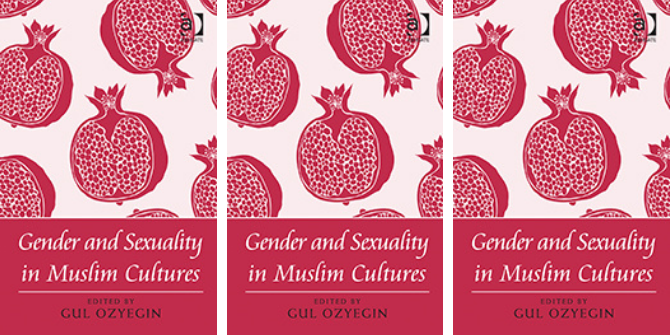In Sex and Gender, editors Alice Sullivan and Selina Todd marshal a range of academics in different fields – from neuroscience to sociology – to explore the relationship between sex, gender and gender identity. Encompassing a broad range of topics and lenses, the volume presents illuminating research in this contested area, writes Lucinda Platt.
Sex and Gender: A Contemporary Reader. Alice Sullivan and Selina Todd (eds.). Routledge. 2023.
 Sex and gender have become highly contested terms, with substantial confusion about their meanings and relationship to each other. This edited volume provides valuable clarification on many of the issues and claims relating to sex and gender in contemporary society. Its fifteen chapters come from experts in their fields, covering topics and disciplines from biology and neuroscience to sports, history, law, philosophy, criminology and sociology, allowing wide-ranging consideration of discussions about sex and gender.
Sex and gender have become highly contested terms, with substantial confusion about their meanings and relationship to each other. This edited volume provides valuable clarification on many of the issues and claims relating to sex and gender in contemporary society. Its fifteen chapters come from experts in their fields, covering topics and disciplines from biology and neuroscience to sports, history, law, philosophy, criminology and sociology, allowing wide-ranging consideration of discussions about sex and gender.
The authors all recognise that sex is a biological referent – ie, immutable and determined at conception – but they provide a range of ways for thinking about gender as a social category, with different emphases on patriarchy (eg, Jones), socialism (eg, Todd), and the role of the state. They share an emphasis on the importance of clarity around terms: the authors take care with their language, and their articulation of concepts, whether the conception of woman (Stock) or sex itself (Hilton and Wright), its measurement (Sullivan, Murray and Mackenzie), or how “inclusion” has been reformulated to encompass the exclusion of women’s concerns (Benjamin; Devine). Such clarity is especially important in a context where the commonly understood meaning of words relating to sex and gender has been undermined.
My first thought on reading this collection was the extent to which assumptions, which were only recently taken for granted as self-evident, now have to be spelled out.
My first thought on reading this collection was the extent to which assumptions, which were only recently taken for granted as self-evident, now have to be spelled out. For example, that woman has a singular meaning, even if there is great heterogeneity among women themselves (Stock; Jones; Todd; Auchmuty and Freedman; Devine); that sex is both binary and immutable – and that humans are not clownfish (Hilton and Wright); that the commonplace use of “gender” to designate men and women (ie, sex) that was unproblematically understood as such, whether in nineteenth century novels, legal discussions or contemporary economic analysis, is now easily, or wilfully, misunderstood and typically needs to be caveated (Stock; Auchmuty and Freedman; Sullivan, Murray and Mackenzie); that that those with disorders or differences of sex development (DSD)s do not represent a ””third sex”, since disorders in development or “limit cases” do not alter the fact that there are two sexes among humans, as all mammals (Hilton and Wright; Stock; Sullivan; Devine). The volume helpfully evidences such points.
The contemporary regular conflation of the term “gender” [… ] has also raised questions about how “gender identity” can be understood without reference to (regressive) gender stereotypes.
The contemporary regular conflation of the term “gender” (as the social organisation of society around particular understandings of men’s and women’s roles and positions) with “gender identity”, which implies an identification with a “gendered soul” that may or may not reflect one’s sex, has clearly generated much confusion. It has also raised questions about how “gender identity” can be understood without reference to (regressive) gender stereotypes. The frequent insistence that any discussion of or teaching on “gender” (as social organisation or the cultural basis of inequality) must necessarily involve discussion – or endorsement – of “gender identity”, has impacted many teachers and educationalists (myself among them). For them, this book offers a useful resource that can help to clarify the scope of discussion of gender around the particular topics being addressed, whether biology, education or criminal justice.
Beyond this, the book provides original insights in its different chapters and highlights some recurrent themes across the diverse discussions. Being introduced to accounts from different disciplines, I learnt a lot about what we do and do not know. The chapter by Scott, for example, on sex and the brain argues that while there are clear physical differences (male brains are larger and women’s have proportionately more grey matter), the implications for behaviour have been more elusive. There is little evidence for distinctively female or male brains in terms of (culturally formed) expectations about differences in men’s and women’s abilities or behaviour. Scott also highlights how some key areas of well-attested differences in male and female behaviour (eg, aggression) have been neglected by cognitive neuroscientists, and comments on the ways in which disciplines find some questions harder to ask than others.
There is little evidence for distinctively female or male brains in terms of (culturally formed) expectations about differences in men’s and women’s abilities or behaviour.
Such absence of evidence and claims-making without a solid evidence base, with important consequences, is a theme that recurs across a number of chapters. Sullivan, Murray and Mackenzie highlight how the corruption of data collection on sex and the failure to collect good data on gender identity acts in opposition to the substantiation (or otherwise) of claims about gender (identity), potentially negatively impacting the rights and care of trans people (for example, if screening programmes relating to prostate or cervical cancer do not have information on natal sex). Littman discusses the poor evidence base on the dramatic increases among adolescent girls identifying as trans or non-binary; and Devine charts the neglect of evidence on the physical advantage retained by trans women in women’s sport. An apparently cavalier attitude to evidence is perhaps also what has facilitated the extensive “policy capture” that is charted in chapters on the law in the UK (Auchmuty and Freedman), the US (Burt) and education (Benjamin). Auchmuty and Freedman, for example, note that it came to the attention of grassroots organisations that Stonewall had been providing advice on single-sex spaces that was “legally incorrect”. A willingness to misrepresent the law (and the nature of evidence) flouts of course the sorts of norms on which we typically depend for a functioning society.
Disregard for evidence is perhaps most chillingly described in Bigg’s chapter on puberty blockers. While Biggs notes that children prescribed puberty blockers are a small proportion of all those identifying out of their natal sex, they are clearly particularly vulnerable. Biggs charts how at the time the initial (Dutch) protocols on puberty blockers were adopted, the only evidence derived from one patient. Subsequent evidence on outcomes of those treated was misrepresented (eg, a follow up from an original Dutch cohort, based its positive evaluation on only a subsample of those originally treated, and failed to mention that one had died due to post-operative complications related to puberty suppression); or was subject to lack of follow up for longer rather than limited short term outcomes (a point also made by Littman), or was suppressed. Biggs’ own analysis, after a concerted campaign for access, of a group identified for experimental investigation of outcomes from the UK Gender Identity Development Service found no positive effects of puberty blockers, contrary to claims on which roll-out of the treatment was based, a finding recently endorsed in the Cass Report. The argument that puberty blockers are “reversible” was, according to Biggs, a “rhetorical device” without evidence; and despite the limits to follow-up discussed, there is now some evidence for negative irreversible impacts of such treatment.
Despite the extensive coverage of the volume, there are two things I missed. First, while there is a cogently written introduction from Sullivan and Todd setting the scene, I would have appreciated a concluding chapter reflecting on the different perspectives and issues covered in the volume. While some seemed to see an unravelling of ill-informed claims about gender, others seemed to see their consolidation. Can a view be taken on this point? In addition, the ways that the chapters speak to each other (even if in terms of qualifying each other) might have been further drawn out.
Second, while I appreciated the measured and sensitive treatment of issues of “balance” and support of different rights eg, in sport (Devine) or US equality law (Burt), I would have welcomed further reflection on the reach and limits of an “inclusive” agenda (Benjamin), and the importance or not of spaces for women/girls to enjoy separateness or privacy, beyond the obvious cases such as sports (Devine) and prisons (Phoenix).
For those struggling to understand the disputes around the meanings of sex and gender or how to balance fairness and maintenance of the rights of different parties [ … ] this book provides an invaluable and authoritative introduction to the issues.
For those struggling to understand the disputes around the meanings of sex and gender or how to balance fairness and maintenance of the rights of different parties, whether as someone involved in teaching or research, or as an interested lay reader, this book provides an invaluable and authoritative introduction to the issues.
Note: This review gives the views of the author, and not the position of the LSE Review of Books blog, nor of the London School of Economics and Political Science.
Image credit: Darya Palchikova on Shutterstock.







